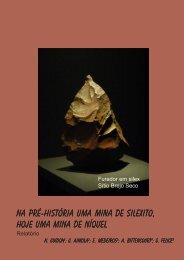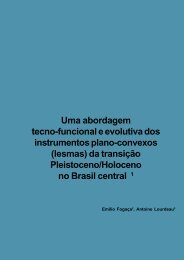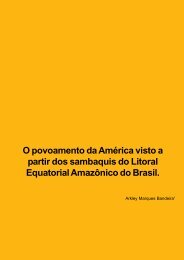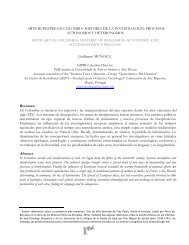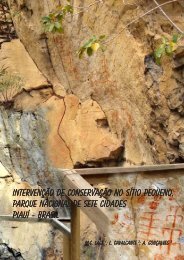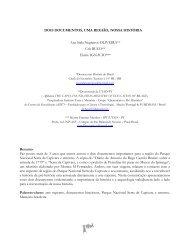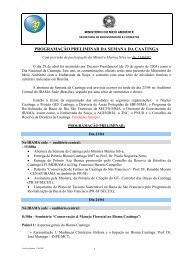Untitled - Fundação Museu do Homem Americano
Untitled - Fundação Museu do Homem Americano
Untitled - Fundação Museu do Homem Americano
Create successful ePaper yourself
Turn your PDF publications into a flip-book with our unique Google optimized e-Paper software.
Global Rock Art Congress<br />
29 Junho – 3 de Julho 2009<br />
24- Imagens são imagens: tema, figura, movimento<br />
composição na arte rupestre mundial<br />
Pictures as pictures: subject, depiction, movement, composition in world rock art<br />
Figures autant que fi gures: thème, dessin, mouvement, composition dans l’art<br />
rupestre mondiale<br />
Imágenes como imágenes: tema, diseño, movimiento, composición en el arte<br />
rupestre mundial<br />
Coordena<strong>do</strong> por / Coordinated by: Christopher Chippindale & Cris Buco<br />
PAPERS<br />
10<br />
Pictures as pictures: subject, depiction, movement, composition in world rock-art<br />
Christopher Chipendalle, Reino Uni<strong>do</strong><br />
A universal issue in rock-art, overlooked and under-researched, is the study of pictures as pictures: why<br />
are four-legged animals depicted this way? Snakes that way? Human beings the other way? Why are<br />
these conventions so often strongly consistent the world over? With good reason – the subjects are often<br />
nearly the same, and the geometrical problem of how to reduce the complex three-dimensional shape to<br />
the simpler two-dimensional shape of the picture certainly is universal. By studying these issues, we can<br />
better understand the conventions of picture-making; we can infer better just what has been depicted;<br />
and we can explore how and if movement can be and is depicted, space and time even, and whether<br />
grouped figures <strong>do</strong> in truth make a composition. Papers are welcomed on any of these interests, using<br />
materials from any or many parts of the world in practical case-studies.<br />
The Dilemma of Symmetry in the Paleolithic Parietal Art<br />
Martin Gamboa, Uruguai<br />
This exposition attempts to explore an enigmatic theme behind the well-known work of André Leroi-<br />
Gourhan. In one of his principal works on Palaeolithic parietal art, he declared the possibility that<br />
Palaeolithic artists practiced symmetry existence. In addition, he found that whether symmetry exists<br />
in Palaeolithic art depends on parietal art and not with mobile art. This significant discovery shows the<br />
distinct evolution and development of both arts. Leroi-Gourhan’s further works of research neither agree<br />
nor disagree with the existence of symmetry in Palaeolithic art. However, Leroi-Gourhan stated that even<br />
if symmetry did not exist in Palaeolithic art, there was an equilibrium “rhythmical” perception between<br />
some Palaeolithic pictures.<br />
(Artigo 92 IFRAO2009)<br />
Parque Nacional Serra da Capivara<br />
Piauí, Brasil




